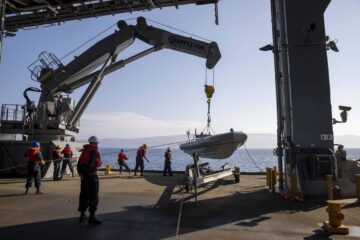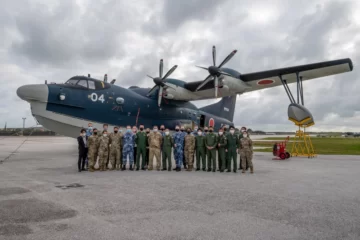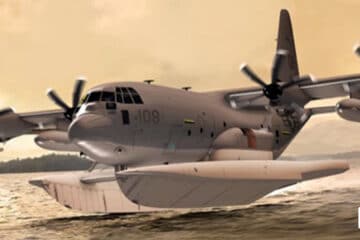Naval News has been following this kit’s development for some time with the U.S. Special Operations Command (USSOCOM) as told here and here. The first news story on this amphibious MC-130J concept can be found here.
Since 2021, the U.S. Air Force’s Special Operations Command (AFSOC) has been developing the amphibious MC-130J and media and public speculation rose as to how the plane would look and function. The answers came to light when AFSOC published graphical renders of the MC-130J amphibious capability (MAC) aircraft resting on two massive pontoons with landing gear sticking out on the bottom for land taxiing and takeoff. Rich Rodriguez, USSOCOM’s Tech Director in Emerging Technologies, spoke at the U.S. Special Operations Forces Industry Conference 2022 (SOFIC 2022 held May 16-19 of that year) and alluded that the MAC will look very similar to the MC-130J graphical renders shown here.

“In terms of amphibious MC-130 demonstration, USSOCOM is actually going through some market research, currently, to see if we can identify any potential amphibious capacities to meet some of the SOF Requirements that are existing. And currently AFSOC is also doing an experimental demonstration where they are planning on putting some float assemblies on a C-130 platform. They use digital engineering as a major factor of reducing some of that risk and making some of those changes, and they have gone through some hydrotesting and some aero testing on a subscale factor.”
Rich Rodriguez, USSOCOM’s Tech Director in Emerging Technologies, SOFIC 2022
Details on the MAC have been scarce since 2021 with USSOCOM and AFSOC providing no additional graphics or information. When queried by Naval News, USSOCOM Public Affairs said that the MAC is not an official Program of Record unlike the DARPA “Liberty Lifter” and no contract exists to construct anything. USSOCOM did admit that the Japanese Maritime Self-Defense Force’s ShinMaywa Industries US-2, a four-engine propeller seaplane with the primary role of Search and Rescue (SAR), contingency operations, and Humanitarian Disaster Relief, was market researched as a possible contender. However, the Japanese ShinMaywa US-2 lacks a spacious cargo hold and a rear cargo ramp, ingress and egress being through a fuselage side door.

ShinMaywa Industries Ltd. did tell Naval News in September 2022 that it is able and confident that it can build the US-2 for USSOCOM if ordered and the main differences would be English instrumentation, software, and technical manuals for any USSOCOM US-2s.
Naval News inquired USSOCOM again in early 2023 on the MAC status, its scheduled fielding, expected performance, and the pontoon kit’s install time. AFSOC’s Public Affairs replied via email on February 13, 2023 with the following statement:
“There is no capability demonstration scheduled for CY23 [calendar year] for reasons that vary from funding challenges to a prioritization of capabilities. The MC-130J Amphibious Capability (MAC) remains an important initiative for AFSOC, and we are still working on bringing this capability for the Joint Force and AFSOC. Sub-scale testing and several risk-reduction activities have been accomplished to date, including advanced digital engineering activities. We are not able to provide specific information regarding when it may reach initial operating capability. And we cannot speculate on any performance issues or provide an accurate length of time it would take to modify the MC-130Js until we reach later phases of the development of this capability. However, we can certainly provide updates in the future as the program progresses.”
Naval News and Author’s Comments
If built and put into service, the MAC would offer USSOCOM and the Joint Force a tremendous advantage in flexible mobility and tactics since the MC-130J can land on and takeoff from water and land. However, as Naval News has previously reported on the MAC, how any internal mobile tactical watercraft (jetskis, combat rubber raiding crafts, small boats, etc.) can enter and exit the rear ramp of a MAC resting so high up on pontoons is unclear and unknown on if the ramp would even touch the water or if the pontoons can ballast the fuselage down to sea level. Also unknown is if the interior can be flooded for roll-on/roll-off of tactical watercraft.
Naval News attended an online Navy webinar held virtually during the COVID-19 pandemic and asked about the U.S. Navy’s interest in the MAC for distributed maritime operations. The U.S. Navy officers present during the session told the media that the Navy is also interested in an amphibious C-130, but the webinar officers have not seen any prototype or official program yet. If the U.S. Navy and the Joint Force branch services can fund the MAC similar to the F-35 Joint Strike Fighter program is uncertain, or if the MAC is entirely a USSOCOM/AFSOC initiative. The U.S. Navy, U.S. Marine Corps, and U.S. Coast Guard do have and fly C-130s although these lack the specialized USSOCOM/AFSOC features such as forward looking infrared (FLIR) turret ball, inflight refueling receptable, sensors, radar, and other U.S. special operations government furnished equipment (GFE). Nonetheless, speculatively, the pontoon kit is supposed to be adapted to any C-130 since it fits on the bottom of the C-130 although it might not be a simple conversion to do and might require many hours to modify a C-130 into a MAC.
To not have a C-130 floatplane affects the future distributed maritime operations and lethality of the Joint Force for the United States, especially in remote regions where a landing strip is scarce. While the technical feasibility and capability of a MC-130J MAC remains to be seen, DARPA and ShinMaywa offer seaplane alternatives that could be beneficial for the U.S. naval forces if built for the former and acquired for the latter despite both seaplanes not being the same size or capabilities as the AFSOC MAC.
In a time of great peer nation competition, delays or funding issues that affect innovative concepts and stalls enhanced maritime mobility might come back to haunt the United States’ Department of Defense as the future world might become more unpredictable and uncertain due to changing times, shifting political climates, turbulent weather, shaky economies, and increased instability of regional global tensions. A MAC offers the Joint Force more options and tactical unpredictability for deploying small watercraft from a distance.
Stayed tuned to Naval News for future updates on the AFSOC MAC program.






